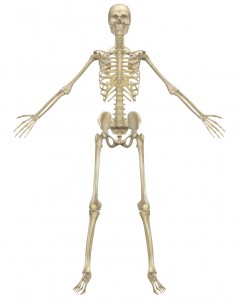I’ve been thinking about bones lately. Remember the jingle we learned as kids: “The hip bone is connected to the thigh bone, the thigh bone is connected to the knee bone, the knee bone is connected to the shin bone…”? That jingle can go on for some time since there are 206 bones in your body, from the large, thick femur that spans the length of your thigh to the tiny, thin stapes, a stirrup-shaped bone that transmits sound inside your ear. Your skull alone has 22 bones (my mother always told me I have a hard head).
Like a fickle home owner who can’t decide if the kitchen should be English country or art deco, bones are constantly remodeling themselves. Bone cells called osteoclasts remove small areas of old bone (called resorption) and other cells called osteoblasts synthesize new bone in its place (called formation). This cyclic process of bone resorption and formation occurs throughout your life, with formation exceeding resorption until about age 30, when bone mass peaks. During your 30s, resorption begins to exceed formation, with bone mineral density (BMD) decreasing by about one percent per year.
Research has shown that female athletes who participate in sports involving running and jumping—soccer, running, basketball, and volleyball—have greater BMD compared to non-active people and even compared to athletes in non-impact sports, such as swimming, cycling, cross-country skiing, and rowing.
Research has also shown that tennis players have greater BMD in their playing arm compared to their non-playing arm, suggesting that the effect of forceful muscle contractions alone is enough to increase BMD. Although athletes have greater BMD, it’s hard to say that exercise is its cause since research has shown that BMD increases by only 1 to 2 percent in response to a training program. It’s possible that people with genetically denser bones are more likely to participate and succeed in sports that are stressful on the skeleton.
High-impact activities and weight training have the greatest impact on BMD. If you’d rather weight train than somersault on a balance beam, you only need one set of a heavy weight to increase BMD, since the magnitude of the stress on the bone is more important than the number of times you repeat the stress.
If you’ve got kids, exercising before they reach skeletal maturity is important because the greatest impact on bone mass is achieved when a substantial exposure to mechanical loading occurs before puberty. As we age, the capacity of bone to respond to loading decreases. It’s like choosing the best 401(k) plan when you’re young to maximize your financial status upon retirement.
As is the case with muscles, tendons, and ligaments, too much stress on bones can cause injuries. Weight-bearing sports like running are more likely to incur bone injuries. Interestingly, for women, a decrease in estrogen level over a long duration is also associated with a decrease in BMD, which explains why a woman’s risk for osteoporosis and fractures increases dramatically with amenorrhea (loss of menstrual cycles) and after menopause, when there is a lack of estrogen. Estrogen deficiency is the most significant risk factor for osteoporosis in active women.
Milk, along with other dairy products, contains two essential nutrients for bone health: calcium and vitamin D. Calcium directly increases bone formation by being directly deposited into bones, while vitamin D does so indirectly by increasing intestinal calcium absorption and by increasing bone resorption to provide calcium from “old” bone to make “new” bone. The sun is also a key source of vitamin D.
Another important nutrient for bones is Vitamin K, which is in green leafy vegetables. Vitamin K assists in the synthesis of osteocalcin, a bone protein that attracts calcium.
Here are some strategies to increase bone mineral density and maintain bone health, especially as you age:
Exercise
High-intensity resistance exercise
Resistance exercise that focuses on the muscles of the lumbar spine and anterior/posterior hip regions
Plyometric exercises (box jumps, depth jumps, leg bounding, etc.)
Emphasize movement in varying directions
Weight-bearing exercise during adolescence, before skeletal maturity is reached
Nutrition
1,000 milligrams of calcium per day (ages 19-50); 1,200 milligrams per day (age over 50)
400 International Units of vitamin D per day (ages 19-50); 600 to 800 International Units per day (age over 50)
Adequate caloric intake to meet metabolic needs
If you’re in the San Francisco Bay area, New Jersey, or Bangkok, I’ll be teaching the Run-Fit Specialist certification near you this summer. Check out our live workshops or take the home-study course!


2 Responses to Bones, Estrogen, and Milk